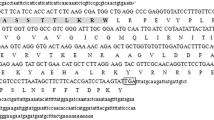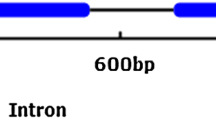Abstract
Among higher plants, soybean is unique in that biochemically it has been characterized as having two constitutive nitrate reductase (cNR) isoforms and one substrate-inducible nitrate reductase (iNR) isoform in leaves. All three NR isoforms are expressed in cv. Williams 82 while the nr1 mutant expresses only the iNR isoform. The genetic and molecular mechanisms for regulation of these isoforms have not been elucidated. We describe here the isolation, by reverse transcription-polymerase chain reaction (RT-PCR), of two cDNA clones encoding soybean NR. They were designated as iNR1 and iNR2, respectively, since both were inducible by nitrate. The iNR1 and iNR2 cDNAs cover total encoding regions of 2661 and 2673 nucleotides, respectively. The iNR1 clone shows a 12 bp deletion at the 5′ end, relative to iNR2. They show overall similarity of 89% at the nucleotide level, and 87% at the amino acid level. Like all plant NRs cloned so far, deduced acid sequences between iNR1 and iNR2 show greatest variation at the N-terminal region while no difference was observed at the C-terminus. Soybean iNR mRNAs were found to be different from those of maize and tobacco in response to tungsten inhibitor treatment, since the inhibitor decreased the steady-state levels of mRNA for soybean iNR and for NiR. Using the same 5′ regions of both cDNAs as the probes, Southern blot analysis of genomic DNA revealed differences in organization between iNR1 and iNR2. The genomic DNA from wild-type Williams 82 soybean was shown to have three Eco RI fragments while the nr1 mutant lacked an 8 kb fragment when probed with iNR1 cDNA. Likewise, the nr1 mutant lacked three Hae III restriction fragments when probed with iNR1 cDNA. When probed with iNR2, both wildtype and nr1 mutant showed one identical Eco RI band and two identical Hae III bands. In northern blots, the steady-state level of iNR1 mRNA was similar for the nr1 mutant and the wild-type parent after 20 to 48 h induction by nitrate. Based on the Eco RI and Hae III restriction enzyme digestion patterns observed in Southern blot analysis of soybean DNA, it is concluded that in soybean iNR1 is encoded by a small multiple gene family and iNR2 is a single gene.
Similar content being viewed by others
References
Back E, Burkhart W, Moyer M, Privalle L, Rothstein S: Isolation of cDNA clones coding for spinach nitrite reductase: Complete sequence and nitrate and nitrate reduction. Mol Gen Genet 212: 20–26 (1988).
Beevers L, Hageman RH: Nitrate and nitrite reduction. In: Mifflin BJ (ed) The Biochemistry of Plants, vol. 5, pp. 115–168. Academic Press, New York (1980).
Belanger FC, Kriz AL: Molecular characterization of the major maize embryo globulin encoded by the Glbl gene. Plant Physiol 91: 636–643 (1989).
Campbell WH: Higher plant nitrate reductase and its role in regulation of nitrate assimilation. Physiol Plant 74: 214–219 (1988).
Crawford NM, Campbell WH: Fertile fields. Plant Cell 2: 829–835 (1990).
Crawford NM, Campbell WH, Davis RW: Nitrate reductase from squash: cDNA cloning and nitrate regulation. Proc Natl Acad Sci USA 83: 8073–8076 (1986).
Crawford NM, Smith M, Bellissimo D, Davis RW: Sequence and nitrate regulation of the Arabidopsis thaliana mRNA encoding nitrate reductase, a metalloflavoprotein with three functional domains. Proc Natl Acad Sci USA: 85: 5006–5010 (1988).
Dean JV, Harper JE: Nitric oxide and nitrous oxide production by soybean and winged bean during the in vivo nitrate reductase assay. Plant Physiol 82: 718–723 (1986).
Dean JV, Harper JE: The conversion of nitrite to nitrogen oxide(s) by the consitutive NAD(P)H-nitrate reductase enzyme from soybean. Plant Physiol 88: 389–395 (1988).
Deng M, Moureaux T, Caboche M: Tungstate, a molybdate analog inactivating nitrate reductase, deregulates the expression of the nitrate reductase structural gene. Plant Physiol 91: 314–319 (1991).
Duke SH, Duke SO: Light control of extractable nitrate reductase activity in higher plants. Physiol Plant 62: 485–493 (1984).
Gowri G, Campbell WH: cDNA clones for corn leaf NADH: nitrate reductase and chloroplast NAD(P)+: glyceraldehyde-3-phosphate dehydrogenase. Plant Physiol 90: 792–798 (1989).
Gowri G, Kenis JD, Ingemarsson B, Redinbaugh MG, Campbell WH: Nitrate reductase transcript is expressed in the primary response of maize to environmental nitrate. Plant Mol Biol 18: 55–64 (1992).
Frohman MA: In: Innis MA, Gelfand DH, Sninsky JJ, White TJ (eds) RACE: Rapid Amplification of cDNA Ends, pp. 28–38. Academic Press, New York (1990).
Harper JE: Evolution of nitrogen oxide(s) during in vivo nitrate reductase assay of soybean leaves. Plant Physiol 68: 1488–1493 (1981).
Harper JE: Nitrogen metabolism. In: Wilcox JR (ed) Soybeans: Improvement, Production, and Uses, 2nd ed. Agronomy Monograph 16, pp. 495–531. American Society of Agronomists, Madison, WI (1987).
Heimer YM, Wray JL, Filner P: The effect of tungstate on nitrate assimilation in higher plant tissues. Plant Physiol 44: 1187–1199 (1969).
Hoff T, Stummann BM, Henningsen KW: Cloning and expression of a gene encoding a root specific nitrate reductase in bean (Phaseolus vulgaris). Physiol Plant 82: 197–204 (1991).
Jensen RE, Hoff T, Moller MG, Stummann BM, Henningsen KW: Identification and characterization of a nitrate reductase gene from bean (Phaseolus vulgaris) containing four introns. Physiol Plant 92: 613–623 (1994).
Kleinhofs A, Warner RL, Narayanan KR: Current progress towards an understanding of the genetics and molecular biology of nitrate reductase in higher plants. Oxford Sur Plant Mol Cell Biol 2: 91–121 (1985).
Lahners K, Kramer V, Back E, Privalle L, Rothstein S: Molecular cloning of complementary DNA encoding maize nitrite reductase: Molecular analysis and nitrate induction. Plant Physiol 88: 741–746 (1988).
Langendorfer RL, Watters MT, Smarrelli Jr J: Metabolite control of squash nitrate reductase. Plant Sci 57: 119–125 (1988).
Maniatis T, Fritsch EF, Sambrook J: Molecular Cloning: A Laboratory Manual. ISBN O-87969–136–0. Cold Spring Harbor Laboratory, Cold Spring Harbor, NY. (1982).
Melzer JM, Kleinhofs A, Warner RL: Nitrate reductase regulation: effects of nitrate and light on nitrate reductase mRNA accumulation. Mol Gen Genet 217: 341–346 (1989).
Nelson RS, Ryan SA, Harper JE: Soybean mutants lacking constitutive nitrate reductase activity. I. Selection and initial plant characterization. Plant Physiol 12: 503–509 (1983).
Ryan SA, Nelson RS, Harper JE: Soybean mutants lacking constitutive nitrate reductase activity. II. Nitrogen assimilation, chlorate resistance, and inheritance. Plant Physiol 72: 510–514 (1983a).
Ryan SA, Nelson RS, Harper JE: Selection and inheritance of nitrate reductase mutants in soybeans. Soybean Genet Newsl 10: 33–35 (1983b).
Shah DM, Hightower RC, Meagher RB: Complete nucleotide sequence of a soybean actin gene. Proc Natl Acad Sci USA 79: 1022–1026 (1982).
Shiraishi N, Kubo Y, Takeba G, Kiyota S, Sakano K, Nakagawa H: Sequence analysis of cloned cDNA and proteolytic fragments for nitrate reductase from Spinacia oleracea L. Plant Cell Physiol 32: 1031–1038 (1991).
Smarrelli Jr J, Malone MJ, Watters MT, Curtis LT: Transcriptional control of the inducible nitrate reductase isoform from soybeans. Biochem Biophy Res Comm 146: 1160–1165 (1987).
Streit L, Harper JE: Biochemical characterization of soybean mutants lacking constitutive NADH: nitrate reductase. Plant Physiol 81: 593–596 (1986).
Vaucheret H, Kronenberger J, Lepingle A, Vilaine F, Boutin JP, Caboche M: Inhibition of tobacco nitrite reductase activity by expression of antisense RNA. Plant J 2: 559–569 (1992).
Vaucheret H, Kronenberger J, Rouze P, Caboche M: Complete nucleotide sequence of the two homologous tobacco nitrate reductase genes. Plant Mol Biol 12: 597–600 (1989).
Vaughn KC, Duke SO, Funkhouser EA: Immunochemical characterization and localization of nitrate reductase in norflurazon-treated soybean cotyledons. Physiol Plant 62: 481–484 (1984).
Author information
Authors and Affiliations
Additional information
Trade and manufacturers' names are necessary to report factually on available data; however, the USDA neither guarantees nor warrants the standard of the product, and the use of the name by USDA implies no approval of the product to the exclusion of others that may also be suitable.
Rights and permissions
About this article
Cite this article
Wu, S., Lu, W., Kriz, A.L. et al. Identification of cDNA clones corresponding to two inducible nitrate reductase genes in soybean: analysis in wild-type and nr1 mutant. Plant Mol Biol 29, 491–506 (1995). https://doi.org/10.1007/BF00020980
Received:
Accepted:
Issue Date:
DOI: https://doi.org/10.1007/BF00020980




